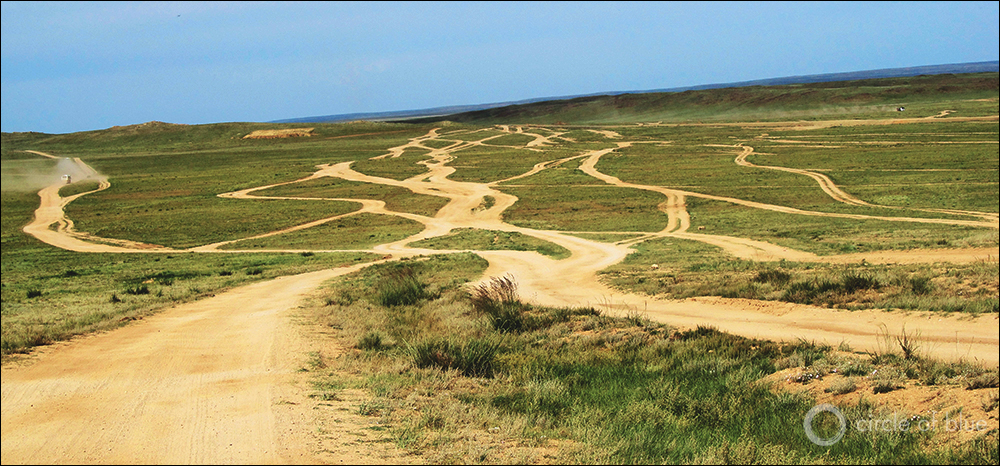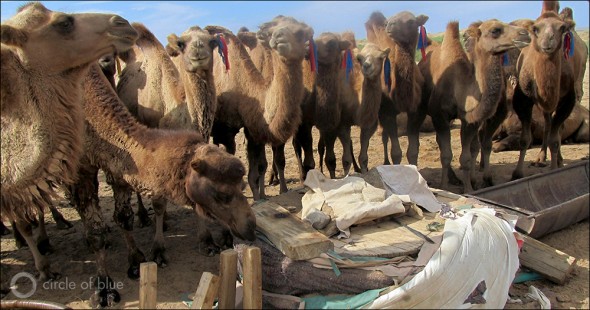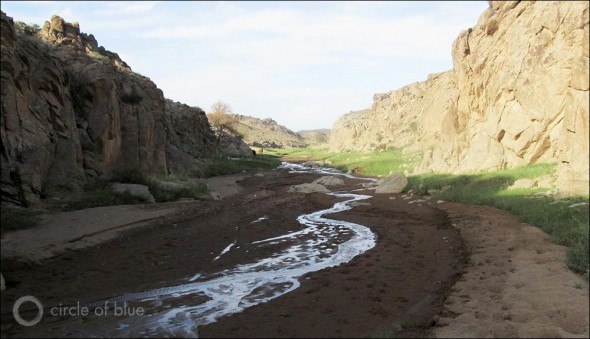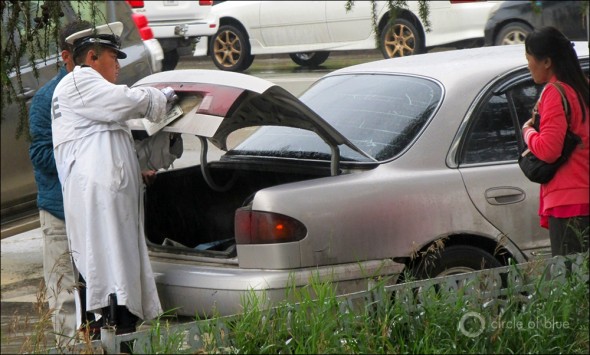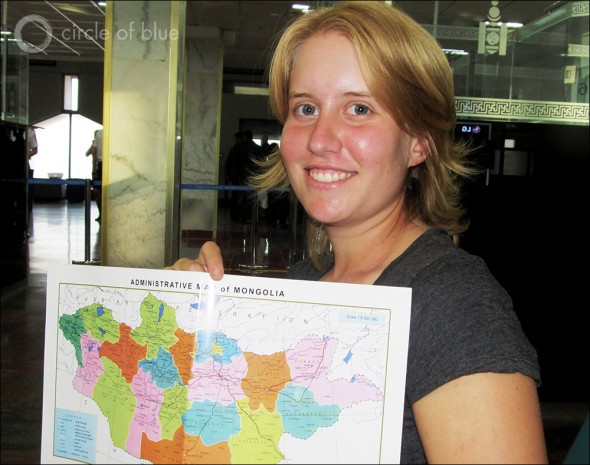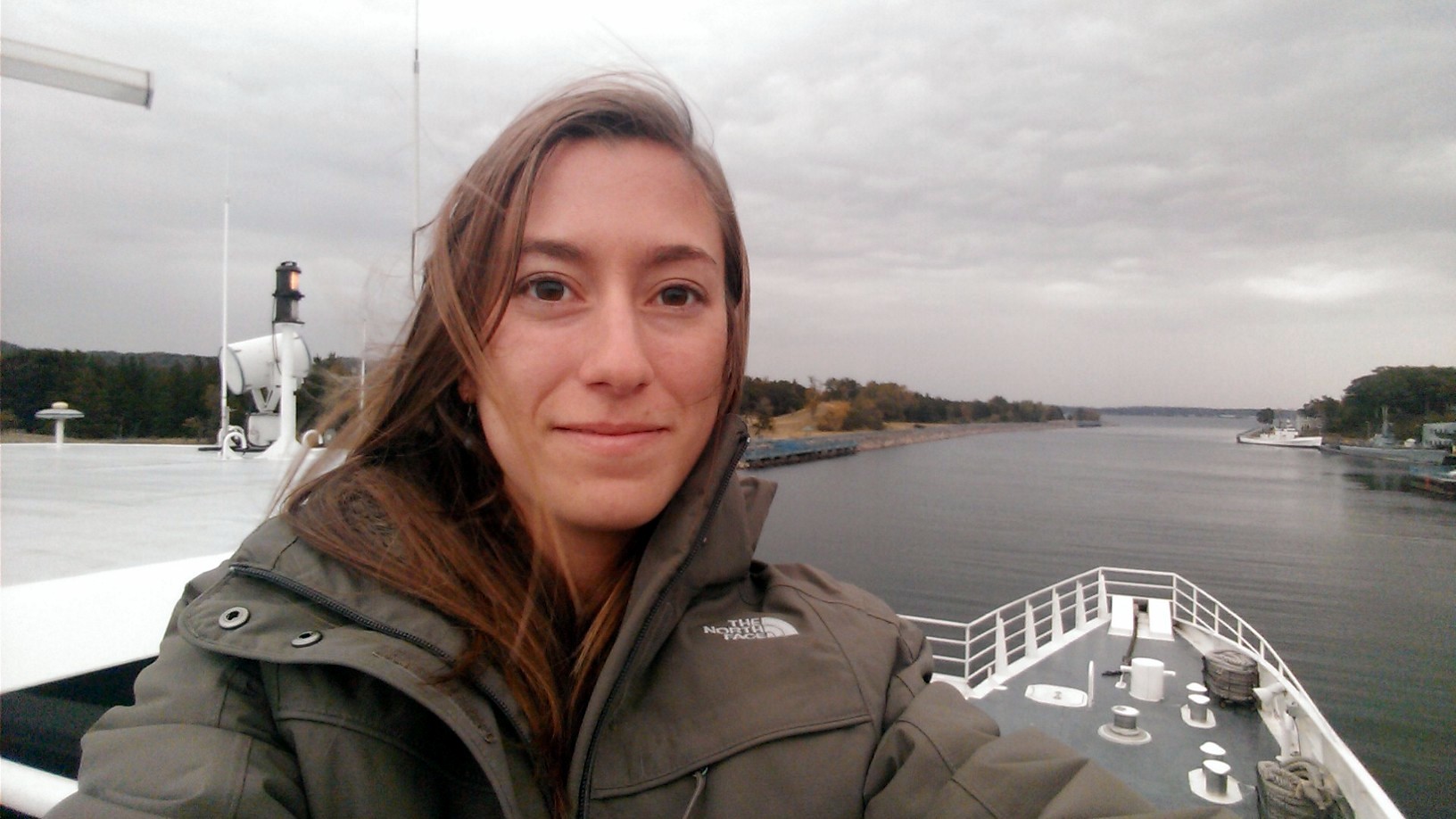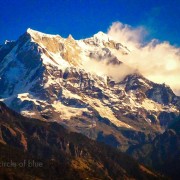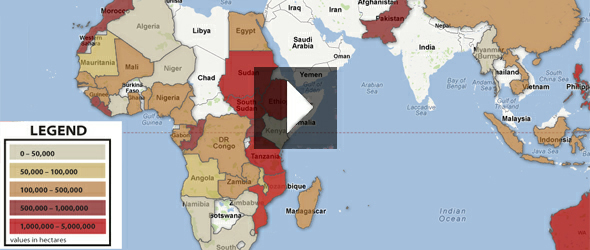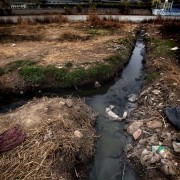TIM: This Is Mongolia
Circle of Blue’s senior editor reports on highway development, food, and global races across Mongolia’s wild lands.
Keith Schneider, Circle of Blue
ULAANBATAAR, Mongolia – Paved roads are still a rarity in this country, which is larger than Alaska and where 1.2 million people – 40 percent of the resident population – earn their keep herding livestock.
The country is all grass and trees in the north, less grass and more sand in the south. Traveling overland between this capital of 1.3 million people and the dusty towns of the South Gobi is a 700-kilometer trip. It takes 15 hours. Four hundred kilometers are on hard-packed dirt roads. Closer to the capital, the informal dirt rights of way expand to encompass multiple paths that climb and descend high ridges.
The multi-tracking, caused by drivers seeking less muddy and more passable routes following rain, form braids that are unique in the world. They also ruin tens of thousands of hectares of grassland.
The Mongolian government expresses strong intent to build paved highways. Mongolia’s prime minister this month complained to the news media that highway construction is proceeding too slowly. But the pace of road building in a developing nation with a $10 billion economy is slow. The national statistics office reports that in the decade from 2000 to 2010, construction crews built 1,100 kilometers of paved highway, or an average of 110 kilometers annually.
At the moment, a good deal of Mongolia’s road building energy is pouring into the country’s southern region to link the capital and the coal and hard rocking mining districts to China. During my trip to report on water supply, herding, and mining in the South Gobi, we used the portions of the new road that were open, speeding along an empty highway at near 80 miles per hour.
By late next year, the entire two-lane highway will be finished and open. In my mind there are many ways to think about that day. The trip south will be faster and easier. The highway will end the multi-tracking, and prompt the recovery of damaged grasslands and desert. In a nation beset by alcoholism, the paved road also will encourage higher driving speeds and many more traffic accidents and deaths.
But the paved road means that visitors will not be able experience the overland route the way we did — with a Mongolian driver watching every hole and bump, and slipping past the big ones. With camels kneeling and grazing by the roadside. With the need to stop every two hours to loosen road-tossed muscles and joints. We moved at a speed slow enough to see the tops of desert grasses. We were aware that there was some peril from a tire blowout or engine failure in the pitch black of a desert night far from the nearest town. It could be hours, maybe a day, before another vehicle passed.
The overland route was an adventure, the closest thing to a stagecoach trip that still exists on the planet. Mongolia’s modernization is visible in the paved roads gradually replacing dirt multi-tracks. It’s visible in blistering bad traffic jams and skycranes atop high-rise office towers in Ulaanbataar, in photovoltaic panels and satellite dishes outside Gobi gers, in westerners venturing across the wild landscape to race on horses, mountain bikes, and fossil-fueled vehicles. TIM: This is Mongolia.
Other Thoughts on Mongolia
No Beggars
In the five days that I spent in Ulaanbataar, I saw one panhandler. He was aged, sitting on Peace Street, the city’s most important commercial boulevard; a small bucket rested on the ground between his knees. I’ve spent time in big cities on four continents. Rich ones like New York and Sydney, Paris and Shanghai. Poor ones like Manila and Detroit. I’ve never been in a big city with fewer beggars. Begging is an act of capitulation, a public display of need and vulnerability. None of those are contained in the Mongolian spirit, drawn from the toughness of a land that broils in summer, freezes hard in winter, and earns much of its wealth milking camels and shearing sheep. Mongols are givers — gifts of food and drink to strangers they meet for the first time, and generous helpings of their time and intelligence. TIM: Mongols aren’t takers.
No Water
The Gobi Desert, which encompasses all of southern Mongolia and almost all of northern China, is the second largest desert in the world, exceeded only by the Sahara. It feels like that, too. Heading south out of Ulaanbataar, the worn highway bridges the Tuul River and then crosses no other river or stream for hundreds and hundreds of kilometers. Eighty percent of Mongolia’s water is underground and a good bit of it is too saline for human consumption without treatment. Just 20 percent of the country’s water is in lakes and rivers, and almost all of that is in Mongolia’s north, close to the border with Russia’s Siberian wilderness. The only running surface water I saw in the Gobi occurred in a spring in Khanbogd, a Gobi mining and herding town near the Chinese border. It flowed from the wind-rounded boulders of a high ridge, tumbled down through a narrow valley of grass and sand, and poured out into pools so clear and welcoming it was evident why people had settled there. A herd of horses, led by a black stallion with a long and shaggy mane, loped off the desert range, settled into a single file, and nervously navigated the knee-high boulders along the spring’s edge. The mares stood in a circle around the stallion, taking their drinks only after he’d taken his. The colts drank last, nose deep in the water, sucking fast because the stallion was already on the move back to the range.
Livestock Everywhere
The world is terribly concerned at the moment about the effects of coal and hard rock mining on the Mongolian landscape and the centuries old culture of nomadic herding. Nomadic herding, though, appears very healthy. The Mongolian livestock herd numbers 40 million animals, according to government figures, or 13 times more than the human population.The expanding herds of cattle, horses, sheep, goats, and camels graze, and overgraze, a natural banquet of grass. From north to south, as the land gets progressively dryer the herds change – from cattle, to sheep and goats, to horses, and camels. The latter are a delight to the eye of a westerner. They pad across the desert on soft feet. They gather in tight groups to rest. Silent and patient, they wait for herders to pour water into metal troughs, then nose each other aside to take a drink. On the way north back to Ulaanbataar we crossed the path of a rare white camel, a female, resting in the road’s cool dirt. I slowly approached her with my camera, clucking and chirping at her. She watched me, then lifted her head and seemed to brighten her smile. Behind her the other adult camels watched the session with traces of irony mixed with jealousy. Very plainly, I wasn’t the first foreigner who’d taken this beauty’s portrait.
Food Not Found In My Grocery
In a desert ger not far from the Mongolia/China border I tasted camel’s milk for the first time. It was thin, cloudy, and carried the scent of the animal that produced it. It also was the first of a short list of exotic animal foods that I allowed to part my lips. In Mongolia, where the diet is heavy in animal fat and protein and food grains, there’s no end to such fare. Fruits and vegetables are not emphasized. Adult Mongolians, as a result, tend to be rounded at the shoulders and hips, and amply stocked in the breast and belly. Most restaurant menus are not translated into English, which makes ordering without assistance precarious. Sheep’s head is a popular item. Brains also are regular fair. Horse meat is a staple. My favorite dish was almost anything with vegetables mixed with lamb and rice. And Mongolia’s Altan Gobi beer is very good.
Brutal Traffic, Terrible Air Pollution, A Capital Wreck
Ulaanbataar, from the looks of it, is challenging Beijing, Xian, and Urumqi, China for worst air pollution in Asia. The city of 1.3 million residents is almost twice as big as it was a decade ago. It sits in a valley, surrounded by high mountain ridges, and prone to air inversions. Big coal-fired electrical generating stations pour coal-ash, dust, and toxic pollutants into the atmosphere. With more residents, and more wealth generation, has come more car and truck ownership. But the surge in vehicles is stranded on the city’s under-sized roads and boulevards. Ulaanbataar, very clearly, did not require the builders of its high rise residential and office towers to pay any sort of development fee to support infrastructure expansion and modernization. There’s no subway. Buses are mired in traffic. Cars and trucks inch along on rutted roads. The city is tattered and dusty on dry days. After heavy rains it’s a wreck. Ponds form in undrained low spots. Mud pours onto roads, and makes sidewalks slippery and so messy store owners and hotels place big mats at their doorways to wipe soles clean.
Enforcing Rules
Western environmental organizations and some Mongolian NGOs worry about industrial modernization and the capacity of the government to establish and enforce rules to protect the land and water. Their doubts are justified. Mongolia, though, certainly knows how to quickly write regulations and enforce them. Not long before we arrived, Ulaanbataar’s new mayor had pushed through regulations designed to help move traffic by reducing the number of vehicles on the road. The strategy is based on license plate numbers. Vehicles with 1 on the plate are prohibited from driving on Monday, 2 on Tuesday, and so on. Violators are issued a warning the first time they are caught, a ticket the second time, and their license plates and vehicles are seized for the third violation. The day before I left I watched the city’s traffic police enforce the rule with steadfast determination. (See pix below) They set up a watch station in front of the State Department Store in one of the city’s busiest shopping areas and they impounded one vehicle after another. It was a lesson in Mongolia’s capacity to be tough with individuals. It’s not as clear whether authorities can muster the same enthusiasm for enforcing environmental safeguards.
Western Adventure Land
To most Americans Mongolia is a metaphor for ‘the ends of the earth,” a destination as far from Lake Street and as remote from the corner store as possible and stilll be on the planet. In many ways, Mongolia really is that place, and for that reason encourages people to travel here in pursuit of wild ass adventure — great mountain treks, harrowing bicycle races, river and overland touring that tests stamina and the outer limits of personal safety. On my way out of Ulaanbataar I encountered two American adventurers who’d just completed once-in-a-lifetime events in Mongolia.
The first is Devan Horn, a 20-year-old Texan and student at Sam Houston State University, and an endurance equestrian rider. She’d just crossed the finish line first in the 1,000-kilometer Mongol Derby, the longest horse race in the world. The course starts in the mountains west of Ulaanbataar and rolls across steppes and through valleys, crossing terrain so wild that Devan encountered a wolf at one point. Thirty riders from North America, Europe, and as far as South Africa started the derby. Fourteen finished. Racing 120 kilometers a day in the first phase, and 160 kilometers a day over the second phase, Devan took 6.5 days to complete the course, finishing an hour ahead of the nearest rider. But that wasn’t sufficient to win. Devan lost the race because of a time violation prompted by a race rule that requires her mount’s heart rate to slow to 64 beats per minute within an hour of stopping. Her horse’s heart beat was 70 at the appointed hour, the result of her charging riding and a lingering equine cold. It cost Devan a two-hour time penalty and the victory. She was disappointed, of course, but also thrilled with what she’d just done — galloping across a landscape that has few equals on the planet. She’d completed the race on August 13, days before most of the other riders crossed the finish line, and hung around to cheer her competitors. “Mostly, we’ve just been partying,” she told me.
The second big trekker is Sean Mathewson, a Californian, Stanford alum, and a graduate student in business at Northwestern University. Sean and three American buddies spent six weeks driving overland in a Daihatsu Terios 4X4, essentially a grossly underpowered SUV that served as their entry in the 10,000-mile plus Mongol Rally from London to Ulaanbataar. The idea is to raise money for charity, principally by auctioning the vehicle at the race’s end. Vehicles are required to have an engine no larger than 1.2 liters. In broad stroke, the “Yurts, Not Cubicles” team followed the basic route of the Mongol tribesman in the 12th and 13th centuries who headed west off the Asian steppe to conquer and settle what we now know as central Asia and eastern Europe. The team survived multiple flats, equipment breakdowns, and various hassles at former Soviet-bloc border crossings. The team also got the name of the round, canvas and felt Mongol nomadic home wrong — ger, fellas, not yurt. Otherwise, they amassed a candy bowl of stories about people and towns and foreign lands that won’t ever be emptied.
-Keith Schneider
Circle of Blue’s senior editor and chief correspondent based in Traverse City, Michigan. He has reported on the contest for energy, food, and water in the era of climate change from six continents. Contact
Keith Schneider


